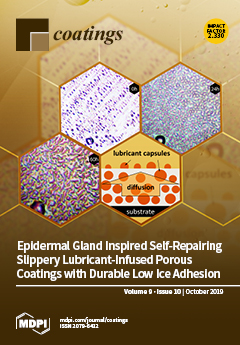The all-sputtered Al/SiO
2/
p-GaN metal-oxide-semiconductor (MOS) Schottky diode was fabricated by the cost-effective radio-frequency sputtering technique with a cermet target at 400 °C. Using scanning electron microscope (SEM), the thicknesses of the electrodes, insulator SiO
2 layer, and
p-GaN were found to be ~250 nm, 70 nm, and 1 µm, respectively. By Hall measurement of a
p-Mg-GaN film on an SiO
2/Si (100) substrate at room temperature, the hole’s concentration (
Np) and carrier mobility (μ) were found to be
Np = 4.32 × 10
16 cm
−3 and μ = 7.52 cm
2·V
−1·s
−1, respectively. The atomic force microscope (AFM) results showed that the surface topography of the
p-GaN film had smoother, smaller grains with a root-mean-square (rms) roughness of 3.27 nm. By
I–V measurements at room temperature (RT), the electrical properties of the diode had a leakage current of ~4.49 × 10
−8 A at −1 V, a breakdown voltage of −6 V, a turn-on voltage of ~2.1 V, and a Schottky barrier height (SBH) of 0.67 eV. By
C–V measurement at RT, with a frequency range of 100–1000 KHz, the concentration of the diode’s hole increased from 3.92 × 10
16 cm
−3 at 100 kHz to 5.36 × 10
16 cm
−3 at 1 MHz, while the Fermi level decreased slightly from 0.109 to 0.099 eV. The SBH of the diode at RT in the
C–V test was higher than in the
I–V test because of the induced charges by dielectric layer. In addition, the ideality factor (
n) and series resistance (
Rs) determined by Cheung’s and Norde’s methods, other parameters for MOS diodes were also calculated by
C–V measurement at different frequencies.
Full article





